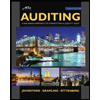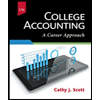I have a question about the Balance Sheet. Is it true that there are two formats (Account Form and Report Form)?Secondly when listing Assets on the Balance Sheet there is an order to following with assets. Example Current Assets are listed first and in order of liquidity. Then the Long Term Assets. Now where to Tangible and Non Tangible Assets fit into this format?
I have a question about the Balance Sheet. Is it true that there are two formats (Account Form and Report Form)?Secondly when listing Assets on the Balance Sheet there is an order to following with assets. Example Current Assets are listed first and in order of liquidity. Then the Long Term Assets. Now where to Tangible and Non Tangible Assets fit into this format?
Cornerstones of Financial Accounting
4th Edition
ISBN:9781337690881
Author:Jay Rich, Jeff Jones
Publisher:Jay Rich, Jeff Jones
Chapter1: Accounting And The Financial Statements
Section: Chapter Questions
Problem 13DQ: Define current assets and current liabilities. Why are current assets and current liabilities...
Related questions
Question
I have a question about the Balance Sheet. Is it true that there are two formats (Account Form and Report Form)?
Secondly when listing Assets on the Balance Sheet there is an order to following with assets. Example Current Assets are listed first and in order of liquidity. Then the Long Term Assets. Now where to Tangible and Non Tangible Assets fit into this format?
Expert Solution
This question has been solved!
Explore an expertly crafted, step-by-step solution for a thorough understanding of key concepts.
This is a popular solution!
Trending now
This is a popular solution!
Step by step
Solved in 2 steps

Knowledge Booster
Learn more about
Need a deep-dive on the concept behind this application? Look no further. Learn more about this topic, accounting and related others by exploring similar questions and additional content below.Recommended textbooks for you

Cornerstones of Financial Accounting
Accounting
ISBN:
9781337690881
Author:
Jay Rich, Jeff Jones
Publisher:
Cengage Learning

Principles of Accounting Volume 1
Accounting
ISBN:
9781947172685
Author:
OpenStax
Publisher:
OpenStax College


Cornerstones of Financial Accounting
Accounting
ISBN:
9781337690881
Author:
Jay Rich, Jeff Jones
Publisher:
Cengage Learning

Principles of Accounting Volume 1
Accounting
ISBN:
9781947172685
Author:
OpenStax
Publisher:
OpenStax College


Auditing: A Risk Based-Approach to Conducting a Q…
Accounting
ISBN:
9781305080577
Author:
Karla M Johnstone, Audrey A. Gramling, Larry E. Rittenberg
Publisher:
South-Western College Pub

College Accounting (Book Only): A Career Approach
Accounting
ISBN:
9781337280570
Author:
Scott, Cathy J.
Publisher:
South-Western College Pub